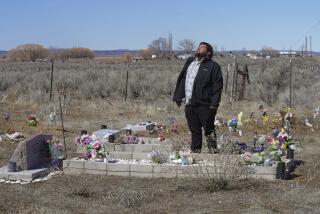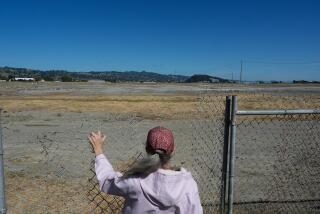Trying to Map Elusive N.Y. Cancer Source
- Share via
WASHINGTON — They are expected to come by the hundreds--average residents with long memories of life on Long Island. With luck, they might be able to help scientists figure out why so many women there are getting breast cancer.
In a hotel in Hauppauge, N.Y.--at the first of seven town meetings over four days--researchers from the National Cancer Institute will listen today to what people remember, or might have heard from a parent or grandparent, about environmental hazards that might have existed years before records were kept.
In rooms decorated with pink and white balloons--the colors that have come to symbolize breast cancer--they will tell of long-closed gas stations, power facilities, military bases or underground fuel storage tanks--even pesticide spraying in areas where farms once thrived.
There will be maps on the walls, and residents will be invited to mark the sites they remember.
With that information, researchers will use digital mapping technology to develop a computerized prototype of “hot spots” that could help prove the thus-far elusive link between chemicals and breast cancer.
Although scientists long have suspected a relationship between environmental pollutants and various forms of cancer, they have been frustrated in their attempts to prove a link.
But if the NCI researchers succeed in producing a visual image that links breast cancer incidence with pollution sites on Long Island, the process ultimately could be used to track other cancers and their possible causes.
The technology, known as Geographic Information Systems, has been around for decades and is used extensively in community and economic development, emergency management and land and natural resource use.
But only recently has it been applied to medical research; the technology has become more sophisticated, public health scientists have become more computer savvy and more information about geography, environmental contamination and disease development is available.
“These applications in health could be very valuable,” said Gerald Rushton, a professor of geography and adjunct professor of public health at the University of Iowa, who is a consultant on the nearly $5-million project.
All over the country’s northeast corridor, from the mid-Atlantic to New England, researchers long have noted a higher-than-expected incidence of breast cancer and deaths resulting from the disease. Nationally, the cancer institute reports, there are 110.6 cases of breast cancer for every 100,000 women, with a death rate of 25.4%. But in Nassau County on Long Island, it is 117.8 cases per 100,000 women, with a 30.6% death rate. And in Suffolk County it is 113.6 cases per 100,000 women, with a death rate of 31.1%.
“It’s very upsetting to us, because we really think something is going on,” said Martha Rogers, a councilwoman in Southampton, in Suffolk County on the eastern part of Long Island, which she says has “an unusually high number of cases, particularly among younger women.”
There is little doubt that residents here will have a lot to say to the researchers.
“I have hundreds of pieces of information that people have given me over the years,” said Barbara Balaban, a member of the board of the West Islip Breast Cancer Coalition. “I’ve saved them all--one who spoke of an Army post and who wondered what might have been stored in the underground tunnels. Another man told me he was a construction worker at a housing development, and there was some question about the materials used in the water lines.
“People talk about Agent Orange along the Long Island Railroad. Someone told me there was a watch factory and that every Friday they dumped the leftover radium into the backyard,” she continued. “I don’t know how much is true, but you have to look at everything--and you have to go way back.”
The mapping is part of the Long Island Breast Cancer Study Project, a federally funded, $26-million effort to determine whether environmental factors are involved in the higher-than-expected breast cancer rates in the Northeast.
Grants also have been approved for the establishment of a breast and ovarian cancer registry, the tracking of possible disease trends among families, and for laboratory testing to trace breast cancer’s development in the body at the cellular level.
Another component is a Columbia University study that looks at whether the now-banned pesticide DDT and polycyclic aromatic hydrocarbons--ubiquitous pollutants caused by the incomplete combustion of various chemicals including diesel fuel and cigarette smoke--are associated with a risk for breast cancer.
“It is a very important research study,” said Joann Schellenbach, an American Cancer Society official. “DDT has been banned for a long time, yet several small studies have found DDT metabolites near the breast tissue of women with breast cancer,” she said. Yet farmers’ wives, presumably exposed more directly to the pesticide, don’t have a higher incidence of breast cancer than women elsewhere in the area who lived in cities.
Susie Roden, 46, grew up in Southampton and was diagnosed with breast cancer at age 39. She suffered a recurrence two years ago, and is now doing well.
But she is puzzled by her disease; no one in her family has ever had breast cancer, and she wouldn’t otherwise be considered at high risk.
At this week’s meetings, she predicted, “we’re going to have a lot of environmental activists who are concerned about the water. Most of us have well water. We grew up with well water. It’s been tested; they’ve told us it was fine. But who knows? I think we did something long ago--and now it’s catching up to us.”






